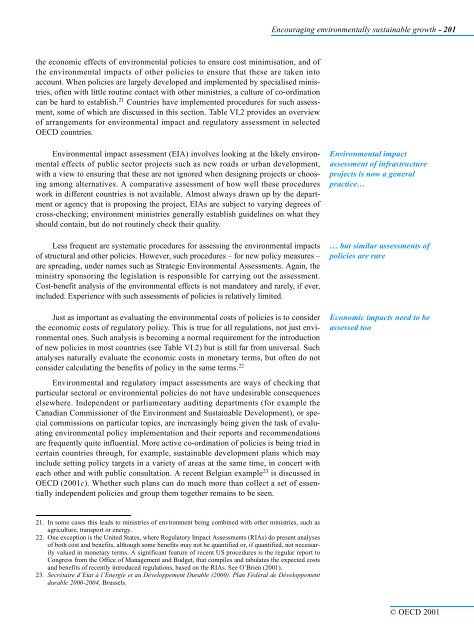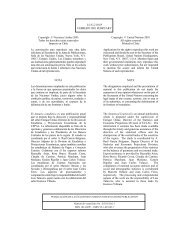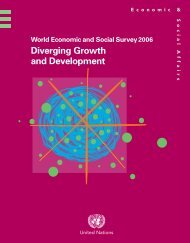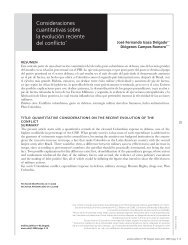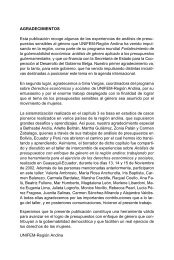OECD Economic Outlook 69 - Biblioteca Hegoa
OECD Economic Outlook 69 - Biblioteca Hegoa
OECD Economic Outlook 69 - Biblioteca Hegoa
Create successful ePaper yourself
Turn your PDF publications into a flip-book with our unique Google optimized e-Paper software.
the economic effects of environmental policies to ensure cost minimisation, and of<br />
the environmental impacts of other policies to ensure that these are taken into<br />
account. When policies are largely developed and implemented by specialised ministries,<br />
often with little routine contact with other ministries, a culture of co-ordination<br />
can be hard to establish. 21 Countries have implemented procedures for such assessment,<br />
some of which are discussed in this section. Table VI.2 provides an overview<br />
of arrangements for environmental impact and regulatory assessment in selected<br />
<strong>OECD</strong> countries.<br />
Environmental impact assessment (EIA) involves looking at the likely environmental<br />
effects of public sector projects such as new roads or urban development,<br />
with a view to ensuring that these are not ignored when designing projects or choosing<br />
among alternatives. A comparative assessment of how well these procedures<br />
work in different countries is not available. Almost always drawn up by the department<br />
or agency that is proposing the project, EIAs are subject to varying degrees of<br />
cross-checking; environment ministries generally establish guidelines on what they<br />
should contain, but do not routinely check their quality.<br />
Less frequent are systematic procedures for assessing the environmental impacts<br />
of structural and other policies. However, such procedures – for new policy measures –<br />
are spreading, under names such as Strategic Environmental Assessments. Again, the<br />
ministry sponsoring the legislation is responsible for carrying out the assessment.<br />
Cost-benefit analysis of the environmental effects is not mandatory and rarely, if ever,<br />
included. Experience with such assessments of policies is relatively limited.<br />
Just as important as evaluating the environmental costs of policies is to consider<br />
the economic costs of regulatory policy. This is true for all regulations, not just environmental<br />
ones. Such analysis is becoming a normal requirement for the introduction<br />
of new policies in most countries (see Table VI.2) but is still far from universal. Such<br />
analyses naturally evaluate the economic costs in monetary terms, but often do not<br />
consider calculating the benefits of policy in the same terms. 22<br />
Environmental and regulatory impact assessments are ways of checking that<br />
particular sectoral or environmental policies do not have undesirable consequences<br />
elsewhere. Independent or parliamentary auditing departments (for example the<br />
Canadian Commissioner of the Environment and Sustainable Development), or special<br />
commissions on particular topics, are increasingly being given the task of evaluating<br />
environmental policy implementation and their reports and recommendations<br />
are frequently quite influential. More active co-ordination of policies is being tried in<br />
certain countries through, for example, sustainable development plans which may<br />
include setting policy targets in a variety of areas at the same time, in concert with<br />
each other and with public consultation. A recent Belgian example 23 is discussed in<br />
<strong>OECD</strong> (2001c). Whether such plans can do much more than collect a set of essentially<br />
independent policies and group them together remains to be seen.<br />
21. In some cases this leads to ministries of environment being combined with other ministries, such as<br />
agriculture, transport or energy.<br />
22. One exception is the United States, where Regulatory Impact Assessments (RIAs) do present analyses<br />
of both cost and benefits, although some benefits may not be quantified or, if quantified, not necessarily<br />
valued in monetary terms. A significant feature of recent US procedures is the regular report to<br />
Congress from the Office of Management and Budget, that compiles and tabulates the expected costs<br />
and benefits of recently introduced regulations, based on the RIAs. See O’Brien (2001).<br />
23. Secrétaire d’Etat à l’Energie et au Développement Durable (2000). Plan Fédéral de Développement<br />
durable 2000-2004, Brussels.<br />
Encouraging environmentally sustainable growth - 201<br />
Environmental impact<br />
assessment of infrastructure<br />
projects is now a general<br />
practice…<br />
… but similar assessments of<br />
policies are rare<br />
<strong>Economic</strong> impacts need to be<br />
assessed too<br />
© <strong>OECD</strong> 2001


